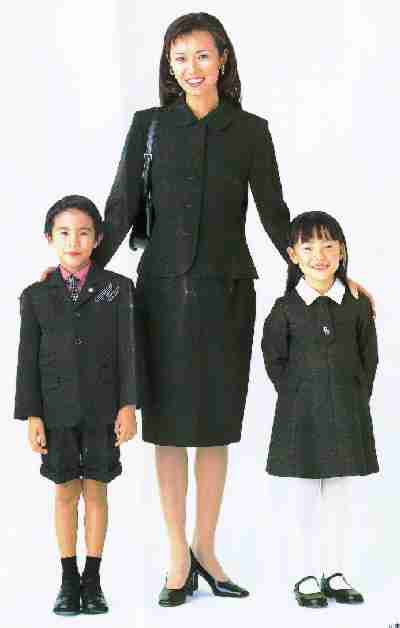Famous Private and National Elementary School Entrance Interview Fair
Japanese department store catalogs, like those from other countries,
provide many useful details about popular boys' fashions. Unlike
fashion magazines, the department store catalogs provide information
on fashions often selling. The fashion magazines sometimes provide more
fanciful information about fashions that designers and mothers would like
for their boys rather than what was actually worn.

Figure 1.--Japanese short pants suits by the late 1990s had changed significantyly.
Even for interviews for condervative private schools, department stores offered suits
with knee length shorts and non-traditional non-white shirts. This boy wears a conservative
suit, but note the double pockers. Despite the conservative suit, he wears a rather
flashy pink shirt.
|
School Interview Fashions
It is critical in Japan for even elementary-age school children to get
into the right school. Schools schedule interviews in which they
assess both children and parents. Prestigious schools have many more
applicants than they can accomodate. These schools include both private
schools as well as a small number of national (state funded schools) that
serve as feeder schools to well-regarded national highschools and
national universities. (Note: In Japan the national government maintains a small number of
excellent elementary and secondry schools as well as the country's
most prestegious universities.)Graduates of these feeder schools are
exempted from the entrance examinations that is referred to
as "exam hell" in
Japan. The children that do get into the prestigious universities
are almost guaranteed a good job offer from important corporations.
As a result, the stakes are high for the children and parents attending
even elementary school interviews. The parents feel the need, with
some reason, to make a good impression at these interviews.
Fashion Trends
A comparison of the catalogs distributed at the annual school fashion fair
provide an interesting window on Japanese boys fashions in general and school
fashions specifically.
Department stores in the early 1990s were still recommending conservative suits or
blazers with conservative grey or blue shorts. The shirts were always white. The shorts were still short. Kneesocks or conservative colored ankle socks were recommended. Usually white or navy blue.
A much wide range of short pants suits were deemed acceptable in 1999. There were
many colors beyond navy blue and grey. Colored shirts were acceptable. The short pants were longer, and many were cuffed. Patterened kneesocks, such as argyles were accepted.
Although not yet addressed by this catalog aimed at gaining acceptance to conservative
private schools, the convention of elementary boys wearing short pants suits, was
waiing in Japan as more and more boys were increasingly wearing long pants.
Japanese boys do wear suits as commonly as American and European boys. Many
suits are purchased for school interviews or entrance ceremonies. Most are shrt
pants suits. But other tahn the school ceremonies, there are not a lot of occasions where they are worn.
Christopher Wagner
histclo@lycosmail.com
Navigate the Boys' Historical Clothing Web Site:
[Introduction]
[Chronology]
[Clothing styles]
[Biographies]
[Bibliographies]
[Contributions]
[Countries]
[Boys' Clothing Home]
Navigate the Boys' Historical Clothing Japanese pages:
[Return to the Main Japanese page]
[Japanese department store catalogs]
[Japanese school uniforms]
[Japanese choirs]
[Japanese monarchy][Japanese Scouts]
[Japanese recitals]
Created: July 27, 1999
Last updated: July 28, 1999
